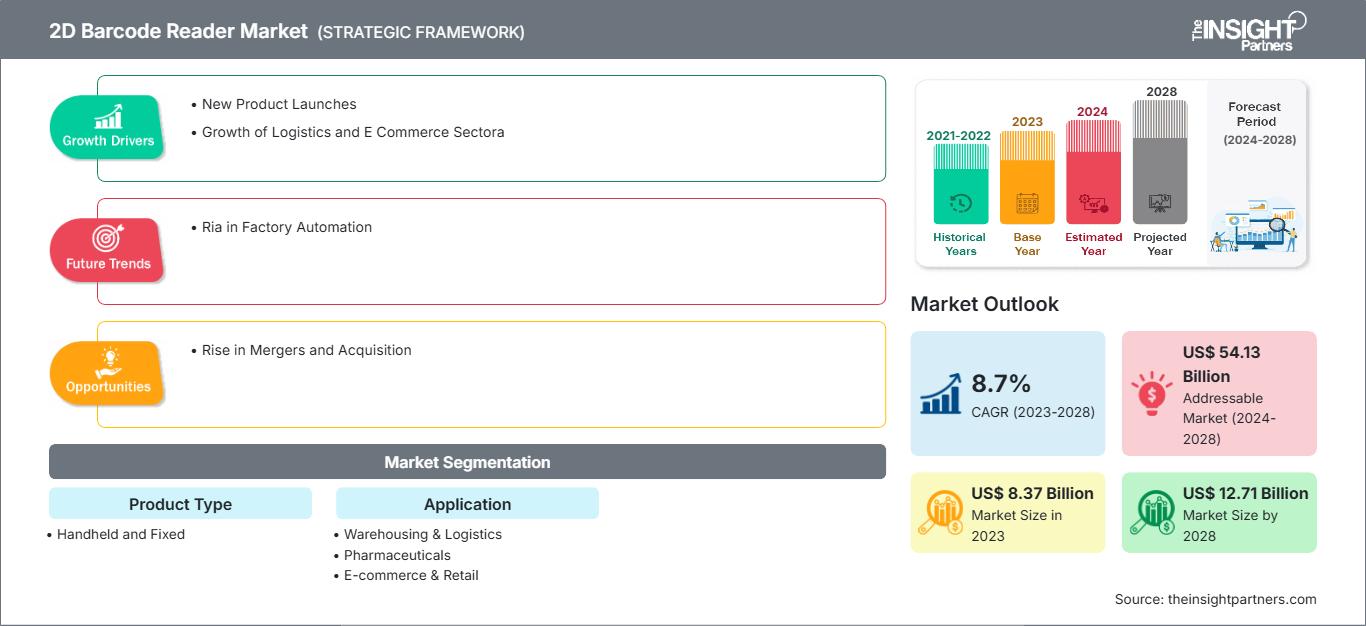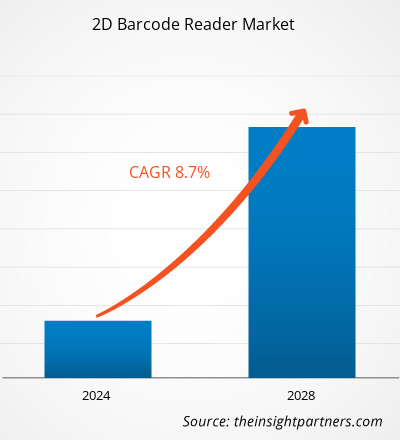[Research Report] The 2D barcode reader market is projected to reach US$ 12,708.70 million by 2028 from US$ 8,373.12 million in 2023. it is expected to grow at a CAGR of 8.7% during 2023–2028.
Factory automation is the implementation of technologies and machines to automate manufacturing processes in order to increase production output and reduce labor costs. It also helps improve the quality of the products by minimizing the risk of human error. Hence, market players are increasingly adopting factory automation which is consider a 2D barcode reader market trend. For instance, in April 2023, Laminar, an automotive technology company, started its operations from the newly developed automated factory. The automation in the factory will help increase the volume of the production units of the sensors. In addition, in November 2022, an electric vehicle (EV) startup, "Weber Drivetrain," opened an automated facility in Pune, India, to produce EV parts. The facility consists of semi-robots and machinery. Such instances will encourage other market players to boost their production output by automating their facilities. Automated factories are increasingly using 2D barcode readers to enhance product tracking and identification. These readers provide accurate product information compared to manual product tracking. They further increase the speed of production output and track information about a product's manufacturing dates and batch number with the help of the product's unique code. This information helps the operator better manage the business processes by providing constant access to the product’s real-time information. Therefore, the rise in factory automation is expected to be a 2D barcode reader market trend during the forecast period.
Customize This Report To Suit Your Requirement
You will get customization on any report - free of charge - including parts of this report, or country-level analysis, Excel Data pack, as well as avail great offers and discounts for start-ups & universities
2D Barcode Reader Market: Strategic Insights

-
Get Top Key Market Trends of this report.This FREE sample will include data analysis, ranging from market trends to estimates and forecasts.
The US, Canada, and Mexico are among the key countries in North America. The continuously evolving manufacturing industry remains the major factor driving prosperity, jobs, and innovation, as the region is a hub for technological development. In January 2021, US President announced the plan to strengthen the manufacturing sector in the US under the “Made in America” initiative, which focused on establishing technologically advanced and automated manufacturing sectors. Under this initiative, an investment of US$ 300 billion was made for the R&D and inclusion of advanced technologies to boost the country's production output. These technological advancements and automation can act as a catalyst for the US economy. Therefore, the rise in automation in the manufacturing sector in the region is expected to increase the demand for 2D barcode readers, along with a surge in the use of machines and systems to replace manual tasks. A 2D barcode reader helps track the product's information through the manufacturing process, which propels its demand in the manufacturing sector and fuels the 2D barcode reader market growth in North America.
The COVID-19 pandemic positively impacted the e-commerce sector across the globe. During the COVID-19 outbreak, due to a surge in online shopping platforms, e-commerce sales in the US and Canada witnessed significant growth in 2020. In the same year, shoppers shifted to online platforms to purchase different types of products, such as health & hygiene products, medicines, and hand sanitizers. Therefore, the demand for 2D barcode scanners increased in e-commerce as barcodes are used in shipping and sorting systems. The pandemic caused dynamic growth in e-commerce across countries such as the US and Canada, and it has increased the production of 2D barcode readers in e-commerce. In several countries, e-commerce transactions have partially shifted from scanning luxury products to daily necessities. Hence, the applications of 2D barcode readers have increased. This has helped the 2D barcode reader market growth further.
Market Insights – 2D Barcode Reader Market
Based on application, the global 2D barcode reader market size is segmented into warehousing & logistics, pharmaceuticals, e-commerce & retail, and others. 2D barcode readers are an essential part of the pharmaceutical industry. The readers enable the accurate tracking of products and capture precise and complete vaccine and drug inventory data. The 2D barcode, especially GS1-Datamatrix, has become the standard for electronic product coding in the pharmaceutical industry. These scanners are used in pharmacy payments and pharmacy drug verification. Pharmacies use 2D barcode readers to scan medicines and other medical products to improve immunization records' data quality. By using 2D barcodes, pharmacies can improve data quality in their facilities. For instance, ISafe Mobile launched a multifunctional IS-TH1XX.1 handheld barcode scanner in April 2021, with integrated smartphones, targeting the pharmaceutical industry. This barcode reader allows pharmacists to scan 2D barcodes to get all crucial data into inventory records. Zebra Technologies Corp, Cognex Corporation, Honeywell International Inc, and CILICO are among the prominent players that provide 2D barcode readers for the pharmaceutical industry.
The 2D barcode reader market size is segmented based on product type, application, and geography. In terms of product type, the 2D barcode reader market is categorized into handheld and fixed. Based on type, the 2D barcode reader market is segmented into warehousing & logistics, pharmaceuticals, e-commerce & retail, and others. Based on geography, the 2D barcode reader market is segmented into North America, Europe, Asia Pacific (APAC), the Middle East & Africa (MEA), and South America (SAM)
2D Barcode Reader Market Regional InsightsThe regional trends and factors influencing the 2D Barcode Reader Market throughout the forecast period have been thoroughly explained by the analysts at The Insight Partners. This section also discusses 2D Barcode Reader Market segments and geography across North America, Europe, Asia Pacific, Middle East and Africa, and South and Central America.
2D Barcode Reader Market Report Scope
| Report Attribute | Details |
|---|---|
| Market size in 2023 | US$ 8.37 Billion |
| Market Size by 2028 | US$ 12.71 Billion |
| Global CAGR (2023 - 2028) | 8.7% |
| Historical Data | 2021-2022 |
| Forecast period | 2024-2028 |
| Segments Covered |
By Product Type
|
| Regions and Countries Covered |
North America
|
| Market leaders and key company profiles |
|
2D Barcode Reader Market Players Density: Understanding Its Impact on Business Dynamics
The 2D Barcode Reader Market is growing rapidly, driven by increasing end-user demand due to factors such as evolving consumer preferences, technological advancements, and greater awareness of the product's benefits. As demand rises, businesses are expanding their offerings, innovating to meet consumer needs, and capitalizing on emerging trends, which further fuels market growth.

- Get the 2D Barcode Reader Market top key players overview
Adesso Inc, Cognex Corp, Newland Auto-ID Tech Co Ltd, Honeywell International Inc, Keyence Corp, OMRON Corp, Guangzhou Netum Electronic Technology Co Ltd, Datalogic SpA, Zebex Industries Inc, and Zebra Technologies Corp. are among the key market players of the 2D barcode reader market profiled during the market study. In addition to these players, several other important companies were studied and analyzed during this market research study to get a holistic overview of the global 2D barcode reader market.
2D barcode reader market players mainly focus on tailor-made solutions to create customer value.
- In January 2023, Cognex designed DataMan 580 fixed-mount barcode reader for logistics tunnels. The company boasts of high-speed operations and improved traceability.
- In January 2023, Adesso acquired WebScience, an Italian software company. It is a strategic move to strengthen its foothold in the Italian market. This acquisition will enable Adesso to expand its portfolio of software solutions and improve its ability to provide tailored services to customers in Italy.
Frequently Asked Questions
What are the driving factors impacting the global 2D barcode reader market?
What will be the global market size for the 2D barcode reader market by 2028?
What is the estimated global market size for the global 2D barcode reader market in 2023?
What is the incremental growth of the global 2D barcode reader market during the forecast period?
What are the future trends of the global 2D barcode reader market?
- Historical Analysis (2 Years), Base Year, Forecast (7 Years) with CAGR
- PEST and SWOT Analysis
- Market Size Value / Volume - Global, Regional, Country
- Industry and Competitive Landscape
- Excel Dataset
Recent Reports
Testimonials
Reason to Buy
- Informed Decision-Making
- Understanding Market Dynamics
- Competitive Analysis
- Identifying Emerging Markets
- Customer Insights
- Market Forecasts
- Risk Mitigation
- Boosting Operational Efficiency
- Strategic Planning
- Investment Justification
- Tracking Industry Innovations
- Aligning with Regulatory Trends





















 Get Free Sample For
Get Free Sample For